
An interesting case arose recently in Canada– Av Singh, a British Sikh, was fired from a Canadian company because his beard raised safety concerns relating to the proper use of a required gas mask.
Removing the beard is against his religious beliefs, so Singh refused the razor and instead hired a human-rights lawyer. [link]
The point that has raised controversy is the length of his beard- about 5 mm (pictured on the right). The objection has been raised by some that he isn’t entitled to protection, becuase he doesn’t keep a full beard.
Now, if this guy is just using religion as an excuse because it’s convenient, then this case is not so hard- religious protection for convenience de-legitimizes real cases of religious discrimination for people that are truly trying to follow and practice the faith. Maybe it won’t be too hard to figure out whether this guy is sincere or not (but maybe it will). But my concern, and the tension, in my eyes, is – where do we draw the line?
I don’t want to underestimate the importance of the physical appearance of a Sikh. But is anyone who doesn’t completely follow the Rehat undeserving of religious protection? Under that definition, there are few real Sikhs in the world, and many that are trying to follow the path want protection against discrimination at airports and on the streets. Why should protection for physical appearance be given over internal belief- just because it’s easier to discern?
Time for another Retreat! This time around its Saanjh and its happening from September 4th to September 7th in the Monte Toyon camp and conference center in Santa Cruz, California.
 According to their website:
According to their website:
The retreat will feature interactive workshops and discussions that will explore topics such as understanding the Guru, exploring our relationship with the Guru, Sikh identity and culture, visiting our recent and past history, Sikh politics and activism. We will utilize an interdisciplinary approach featuring spiritual, philosophical, cultural, historical, political, and activist angles to explore these diverse topics. There will also be different fun activities, sports and games to engage us. We hope to challenge participants to gain a broader and more nuanced understanding of what it means to be a Sikh while inspiring activism.
Registration is now open, and the early registration ends on July 15th, if you plan on attending than register now to avoid the late fees. For more information visit www.saanjh.org
Recently I was having a conversation with a non-Sikh about names and how you can tell the gender of a Sikh individual just by looking at their name. I told her that there really wasn’t a fool-proof way of doing this since many Sikh names can be used by both men and women. However, I told her, when you see “Kaur” and “Singh” used in the name, you have a better chance of identifying the gender since it tells you if the individual is female or male, respectively. (Just to confuse her, I did mention that Singh is often also used by women). We were later joined in our conversation by another Sikh woman who basically refuted my explanation of Sikh names by telling our non-Sikh acquaintance that in fact, she and a growing number of Sikhs in our community actually don’t use “Kaur” and “Singh” at all in their name. The whole conversation reminded me of another similar discussion I happened to have with a Sikh friend of mine who, having married a non-Sikh, said that she had no intention of using “Kaur” or “Singh” in the names given to her children.
Now, while I realize that these are two unconnected conversations and I am by no means suggesting this is a trend of any sort – I do wonder how common this is and what (if anything) it means for the Panth. If, for example, my friend chooses not to raise her children Sikh, then I feel ike it is less problematic that she does not use “Kaur” and “Singh” in their names. However, it is interesting to me when people who identify themself as Sikh choose to shed this identity. I am aware that a name by itself does not necessarily establish an identity. However, I wholeheartedly believe that having “Kaur” and “Singh” bestowed upon us by our Guru was no small thing and in fact, it does establish an identity for Sikhs. By not continuing to use “Kaur” and “Singh” in the names of Sikhs, how much of our identity is being diluted? I do believe that there are enough Sikhs who are conscious of this. Many young Sikh women, including myself, who use “Kaur” as a last name now intend to keep it as a last name after they get married. This is also a significant step in solidifying one’s identity.
Thoughts on this?
Sorry for my long absence. Expect an explanation post very soon.
Although there is more current news, there are two past due topics that need to be discussed in The Langar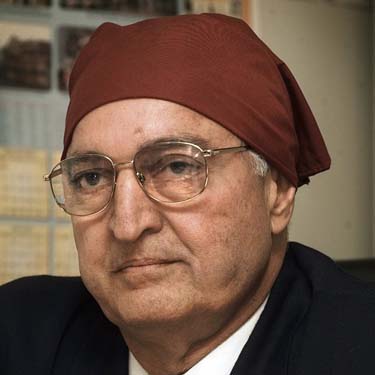 Hall. I begin with the first.
Hall. I begin with the first.
Now while Mack-10’s lyrics in the title of this post may not be completely appropriate, I use them to highlight a possible historic event in the Sikh community in Canada and beyond.
For those of us that grew up in the states, the Dasmesh Darbar of Surrey and the Guru Nanak Sikh Temple of Surrey entered our popular imagination in 1998 when Sikhdom was shaken by the inane “tables and chairs” controversy. A local Surrey conflict soon ballooned throughout the world and even saw violence at a number of different Gurdwaras in North America and Europe. A conflict, which most did not understand, divided local communities and caused rifts that still fester within the Sikh community today.
The worst-affected area was where the controversy initially began – Surrey, Canada. A new vocabulary entered into the language of Sikh-British Columbians: “fundies” verses “moderates.” A generation of Canadian youth saw rishtas broken and dinner conversations centered around “uthay ja thalay” (“up” or “down”).
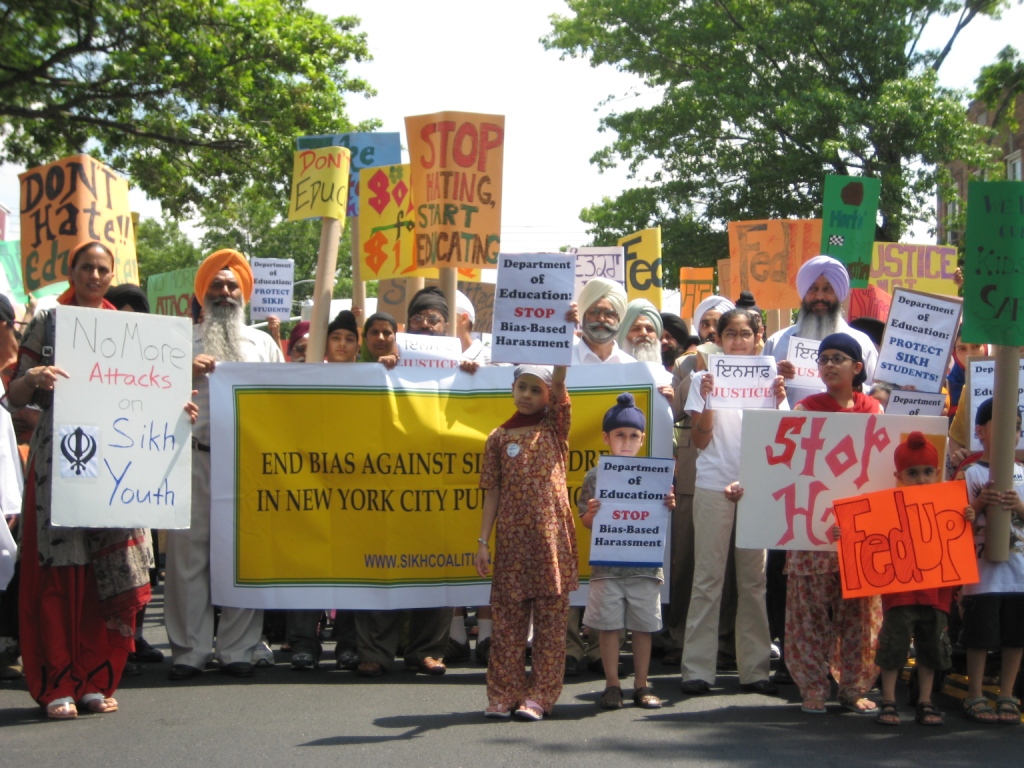 I’ve mentioned before how much I enjoy belonging to such a pro-active community. I don’t know whether it’s the Punjabi, the Sikh, or some combination of the two influences that makes people speak out, but whatever it is, I love it.
I’ve mentioned before how much I enjoy belonging to such a pro-active community. I don’t know whether it’s the Punjabi, the Sikh, or some combination of the two influences that makes people speak out, but whatever it is, I love it.
This picture, I think, portrays why. It speaks volumes. Hundreds of men and women of every age group walked together and made their voices heard in Richmond Hill today.
“Don’t Hate, Educate” and “Fed Up” (says the chotu in the front row on the right).
The girl in the front, center stole a piece of my heart too.
From the Sikh Coalition:
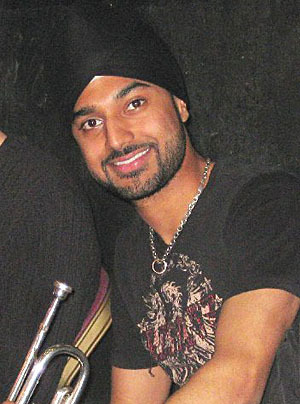 For a place that makes money off turban-wearing and multicultural disney characters, it seems a little ironic that a turban-wearing employee of Walt Disney would be fired for not having the “Disney look.” Uhh what?
For a place that makes money off turban-wearing and multicultural disney characters, it seems a little ironic that a turban-wearing employee of Walt Disney would be fired for not having the “Disney look.” Uhh what?
This story has been getting a lot of press lately (so for the two of you who haven’t heard) Sukhbir Channa applied for a job (as a trumpet player) with Disney in September 2006 but was told that he couldn’t be hired unless he removed his religiously-mandated turban. He was told that he did not conform with Disney’s grooming and dress requirements known as the “Disney Look.” (Okay, but Aladdin does?) Our friend over at SikhSwim makes a good point,
On my last visit to Disney World, little kids, when they saw me, would say, “Hey look, it’s Aladdin!” So I think Disney’s position has no basis. I think Sikhs have the “Disney look” if average people confuse us for some of the popular Disney characters! [link]
SALDEF has stepped in to help Channa with his lawsuit,
“Disney’s position is fundamentally un-American because it forces Sikhs and also observant Jews and Muslims to sacrifice religious freedom in order to pursue their career goals,” said SALDEF Chairman Manjit Singh. “It is also hypocritical for Disney to make millions of dollars promoting cartoon characters that wear turbans and simultaneously reject the right of an employee to wear a turban in accordance with his faith.” [link]
Having earned a bachelor’s degree in music, Channa just completed a nine-month U.S. tour with the Broadway show Annie. We’ll update you as soon as we hear more about this story. In the meantime, what are your thoughts on this and am I the only one impressed that we know a Sikh trumpeter?!
Few programs exist that provide an in-depth study of Sikhi. Fewer exist in the United States. While there are other ventures, such as the Jakara Movement that attempt to allow entry and inspiration, Sikh Research Institute’s (San Antonio, TX) Sidak provides
distinctive learning program for young adults seeking to increase their commitment towards the Sikh faith. This intensive two-week educational experience is a unique program consisting of instructional seminars on various facets of bani (scripture), tvarikh (history), and rahit (discipline). Sessions on leadership development and community building also serve as key foundations for Sidak. [link]
From Harinder Singh‘s esteemed pedagogy, to various learned guest-speakers, and the culmination in a final project, Sidak is an amazing educational and spiritual experience. This year Sidak is being held on 13 – 26 July, 2008. For more information visit www.sikhri.org

The police have apprehended two suspects and are charging them with the killing of Navtej Singh. The police are still searching for additional suspects and accomplices.
————————————————————
Many of our friends and family own small businesses. Whether gas stations or convenience stores, the hours are long and the risks are high. Few of us would probably not be aware of some friends or family that have not had some circumstance occur while working.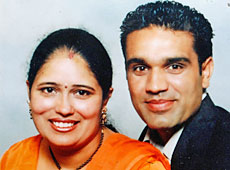
In Auckland, the New Zealand Sikh community suffered a tragedy with the killing of 30 year old, Navtej Singh, a father of three children all under 5 years of age.
Almost as disturbing as the cold-blooded murderers, who stole fifteen bottles of beer and a few dollars, was a callous customer that stole a box of alcopops as the victim lay in his blood.
The 12,000 member Sikh community in New Zealand is an established community with five gurdwaras and are asking questions. There is some division as to whether these crimes have a racial motivation or are crimes of opportunity:
“What is happening in South Auckland?” asked Sandeep Verma, who was with Navtej Singh when he was shot, and when he later died in hospital.
“All the people from the Indian community, whether they are Fiji Indians, Indians, Punjabis, Gujaratis; only those people are the main target.
“What are the police doing for the security of our people?” [link]
A recent play seems to have caught my attention. I provide the description here in length:
Dangalnama is a gripping account of sectarian rioting in India since the assassination of Indira Gandhi in 1984. It is also the story of a younger generation making sense of their history.
Through the voices and personal testimonies of Indian journalists, students, artists and politicians, director Prasad Vanarase presents survival stories, which shed light on the current social, economic and political climate in India today and the wide disparity between the poor-rural and modern-urban population. Performed in five languages (Hindi, Marathi, Gujarati, English and Kannada), this eye-opening and satirical take on Indian’s recent past also looks forward to a more unified future.
Dangalnama boasts a cast of 14 drawn from across India. Using satire and comedy, Dangalnama shows us the human side of India’s complex and often hidden issues in this powerful 90min production followed by a lively 30min discussion with the cast and director. [link]
Dangalnama A Flame Production directed by Prasad Vanarase
A Lift commission / UK Premiere
Fri 13 – Wed 18 June 13, 14, 15, 16, 17: 7.30pm – 9.30pm
15, 18: 2.00pm – 4.00pm
An immediate observation leaps out at me from the description. It is striking though that the play in being performed in five languages, yet the main language of the victims of the genocide, Punjabi, is left out. I wonder why?
Since the Sikh community first learned about Navraj (Nuvraj) Singh Bassi, many on the internet have rushed to create facebook groups, orkut groups, and other fan displays. I think the CFL in general, but the SASKATCHEWAN ROUGHRIDERS, in particular, will see a new group of excited fans.
I think the CFL in general, but the SASKATCHEWAN ROUGHRIDERS, in particular, will see a new group of excited fans.
Many have wondered about Nuvraj Singh Bassi’s status and luckily here in The Langar Hall, we have made friends with some great Roughrider fans, including Behaving Bradley, photographer Downtown Aaron Brown, Giventofly (GTF), and others on the Roughrider Fan Forums.
So from what I gather, Navraj is still a ‘raw’ player, but many are excited about the player he may become. He seems to have suffered a foot injury, but is still in attendance at training camp. We hope him a speedy recovery and the Roughriders a great season! We’ll try to keep you updated with the help of Behaving Bradley and others from the forum!
——————————————
A long time ago, my fellow Langa(w)r-iter, posed the question:
Can a kesdari Sikh man excel at high levels of athletic competition in the U.S. and practice his faith? [link]
Back then she was introducing us to Darsh Singh, Trinity University’s keshadhari (turbaned) Sikh starter and co-captain.
Today, I introduce you to Navraj Singh Bassi.
I had a long and interesting conversation with a friend of mine this weekend on different attitudes towards finance and charity between different world religions. We noted that both Judaism and Sikhi require a 10% charitable contribution, in addition to service, which has no upper or lower bound and serves a different purpose. This dovetailed with a conversation I had with a few friends, including one who is an Islamic banker in Dubai, about religious concepts of usury, interest, and charity.
For many low-income and poor communities, asset/wealth creation is a major hurdle, and access to financial/resource markets and services is non-existent. Although Sikhi has strong proscriptions against materialism, greed (moh), and attachment (maya), it also has a redistributive element. While simplicity is embraced, wealth is not necessarily wholly eschewed (if earned honestly and put to just uses).
If a financial institution were opened upon Sikh principles, what would it look like, to you? What kind of services would it offer, or how would it help address the structural exclusion of the poor? For example, I could imagine very low interest or no interest loans, but perhaps other infusions? In other time periods, Sikhs built free clinics and community schools. Khalsa College, on an endowment from one of its funders, still offers free college tuition to local residents (regardless of religion). What are the kinds of “assets,” beyond simply wealth, that could contribute to Sikh principles of economic justice? Do you feel such principles (i.e., economic justice) exist in Sikhi?
 About a week ago, Sex And The City (SATC) hit theaters. Many may resist an association with the dating scene that the movie and show explored with the lives of Punjabi Sikh women, and wonder whether this is appropriate for The Langar Hall. But the stories and characters of SATC reflect broad ideas that apply to all women and since every woman I know has seen or is planning to see the movie, I’m curious about how these themes apply to Punjabi Sikh women in particular and how our experiences compare with other groups. This post does not promote anything portrayed in SATC, but instead explores the stereotypes in the characters and questions how our Punjabi-Sikh-ness affects how much of those stereotypes we embrace. First, what is SATC really about?
About a week ago, Sex And The City (SATC) hit theaters. Many may resist an association with the dating scene that the movie and show explored with the lives of Punjabi Sikh women, and wonder whether this is appropriate for The Langar Hall. But the stories and characters of SATC reflect broad ideas that apply to all women and since every woman I know has seen or is planning to see the movie, I’m curious about how these themes apply to Punjabi Sikh women in particular and how our experiences compare with other groups. This post does not promote anything portrayed in SATC, but instead explores the stereotypes in the characters and questions how our Punjabi-Sikh-ness affects how much of those stereotypes we embrace. First, what is SATC really about?
the three-girls-in-the-city movie… a cinematic staple since the 1920s, has been an unusually enduring and lucrative one, exploiting each succeeding era’s anxieties surrounding women’s changing roles and helping define those eras’ new ideas of modern life. In them, audiences can watch women negotiate and sometimes subvert the forces that limn and limit their choices. [link]
Prices go up after Monday. Take a moment at work, take a quick break from your finals, but take it now! A commenter asked to for a meet-up at the conference. A few of the bloggers will be in attendance so come meet a few of the faces behind the nonsense we write! Register now at www.jakara.org
———————————————————————————
From our discussions on dividing Gurdwaras to Green Gurdwaras; from confronting the demons within to forging a new consensus; from questions of grassroots movements to moving beyond generation two blues; all are invited to attend JAKARA 2008 and discuss face-to-face these important issues.
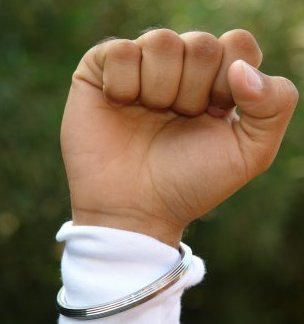 The Jakara Movement Sikh youth conference is only three weeks away with registration closing on June 16th. REGISTER NOW to avoid late fees.
The Jakara Movement Sikh youth conference is only three weeks away with registration closing on June 16th. REGISTER NOW to avoid late fees.
Who: YOU!
What: JAKARA 2008: Growing with our Gurdwara
Where: FRESNO, CA
When: June 19-22, 2008
Why: Because YOU need to be there. Visit the website for more information.
Yes I had urged all to attend in a different post, but consider this a friendly reminder.
Plan to attend, even if you just want to see life beyond bhangra or shoooooooooot, because you just want another Sikh T-shirt (no, you don’t get those ones).
Guest blogged by Mewa Singh
Yesterday’s post by Sundari got me thinking. When I saw the videos of the from the BBC footage from those days in 1984, I began wondering can the Sikh community mobilize like that again? Under what circumstances could it or even should it mass mobilize?
I thought of the mobilization that occurred with the Ram Rahim incident last year. Then while reading the internet news, I came across this Bay Area video.
CLICK HERE TO WATCH VIDEO (sorry the website doesn’t allow me to embed the video)
The media was given the title as the “Spiritual March for World Peace.” Although I have been out of the loop with friends for sometime with my Bay Area friends, what was the ‘real’ reason for the gathering? Was it celebrating the shaheedi of Guru Arjan? Do we really have Nagar Kirtans to remember martyrdoms in our history? Should the march be construed as an anti-war protest? Partially to raise awareness, but partially to learn about the initiative as well, I would love to hear about the background, perspectives, or even your thoughts on this Nagar Kirtan.
Many of us have taken part in discussions on how the turban is being commodified and a target for hatred. Understandably there is a strong religious argument for why a turban shouldn’t become another fashion accessory or replaced with a beanie. This argument is anchored in the Sikh meaning of the turban.
The symbolisms of wearing a turban are many from it being regarded as a symbol of sovereignty, dedication, self-respect, courage and piety but the reason all practicing Sikhs wear the turban is just one – out of love and obedience of the wishes of the founders of their faith.
The turban serves as a mark of commitment to the Sikh Gurus. It distinguishes a Sikh as an instrument of the Guru and decrees accountability for certain spiritual and temporal duties. It is a mark of the Guru and declares that the Sikh wearing a turban is a servant of the Divine Presence.
But what happens to this meaning when the turban is being forced upon non-Sikhs? The Cheema Mandi (near Sangrur), Punjab branch of Akal Academy Buru Sahib is requiring all non-Sikh children to wear a patka or dastaar (i.e. type of turban). Most of these children are practicing Hindus who don’t spiritually identify with Sikhi.
I just wanted to remind all of you out there, particularly those who live in California, that you can still sign up for the annual Jakara Sikh Youth Conference. The conference is in Fresno, California on the Fresno State campus and the dates for this year are June 19-22, 2008. Don’t be lazy, register and avoid a late fee.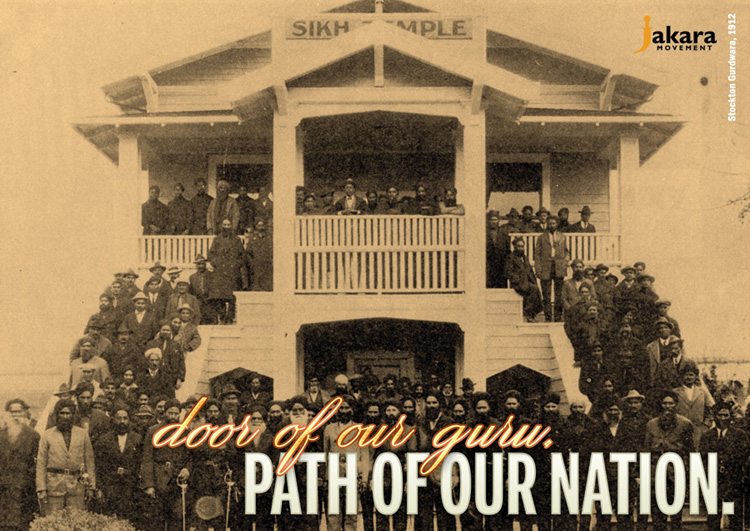
This year’s theme is “Growing with Our Gurdwara.” The introduction from the website are as follows:
They don’t speak our language. They have too much politics.
They are too corrupt.Too few young Sikhs are found at their local Gurdwaras. While young children play outside after Punjabi School and our parents congregate in the langar hall, too many Sikh youth decide not to go to Gurdwara.
However, this does not mean our spiritual thirst has been quenched. It is time for a change. It is time to stop blaming others. It is time for the next generation of Sikhs to empower ourselves and engage with our Gurdwaras. It is time to turn the “they” and “them” into “we” and “us”. The Gurdwara is OUR institution; it will always be the center of Sikh life. It is OUR grassroots democracy if we make it so.
This year at the Jakara Movement Sikh Youth Conference 2008, we will re-create, re-engage, re-emerge with the “door to our Guru”. Join us as we re-kindle our center and grow with our Gurdwara. [link]
A few months ago, my fellow langa(w)riter asked, “Who Speaks for Sikh-Americans?” While we are still waiting for the exciting conclusion (or atleast a second part), recent news over the weekend, makes me also ponder this question.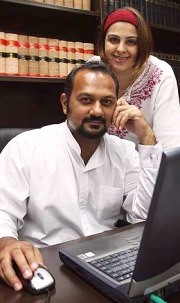
The news came from Pakistan and Malaysia.
In Pakistan, it seems a section of the Sikh community there has demanded
”The Sikhs’ problems could be solved if the community is given representation in the government or if a Sikh is appointed an adviser to the prime minister,” said Swaran Singh, candidate for the post of president of the Pakistan Sikh Gurdwara Prabandhak Committee.
He suggested that an adviser to the prime minister should be appointed to attract Sikhs from other countries to invest in Pakistan. Christians and Hindus have representations in the government, but Sikhs have yet to reach the national or provincial assemblies, he said. [link]
In Malaysia, the news rang out:
Malaysian ethnic Punjabi Karpal Singh and son Gobind Singh Deo have created history by becoming the first-ever father-son duo to be elected members of a Parliament in the world. [link]
I figured I would start off this week with an odd news story – odd, but deserved of some spotlight. Over the weekend it seems that Taliban-aligned groups saved two Pakistani Sikhs from their kidnappers and are threatening to execute the kidnappers to stifle law-and-order problems in the area.
Two Sikhs, who were abducted from a district in Pakistan’s restive North- West Frontier Province (NWFP), have been rescued by the local Taliban and religious scholars, who decided to publicly hang their nine kidnappers on Monday to discourage crimes in the region. Attar Singh and Sehra Singh were kidnapped by a group of criminals from Dowaba in Hangu district. They were freed on Saturday after the intervention of local Taliban, religious scholars and tribal elders, The News reported. [link]
The news may seem shocking. The Taliban, the same forces that destroyed the Bamiyan Buddhists cave-carved figures, are now saving Sikhs?
While by no means should this post be construed that I am somehow supporting the Taliban, I do believe that this small anecdote helps illustrate the complexities of Afghanistan and beg for us to engage in critical analysis, rather than merely parroting reports in the news media.
So yesterday (4/23/08) for all of our valeti readers was Saint George’s Day. For the rest of us that probably don’t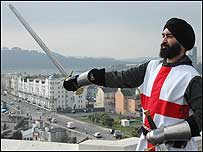 care (including apparently most of England), Saint George is the patron saint of England (sort of like Saint Patrick for the Irish) that:
care (including apparently most of England), Saint George is the patron saint of England (sort of like Saint Patrick for the Irish) that:
[Saint George] was a third-century Turkish soldier who supposedly had the power to slay a dragon but likely never set foot in Britain. [link]
Since he was probably Turkish to begin with, it seems like there should be no problem that Chaz Singh should be the Modern Day Saint George.
Modern Day St. George –> click here to watch BBC Video (love the British teeth!)
Chaz Singh is no newcomer to the media spotlight. He has been highlighted in a traveling picture exhibition as well as been commented upon by some popular desi blogs:
Chaz Singh is one of the recipients of the BBC Breeze bursaries that has enabled him to develop his ideas about identity in a series of photographic images and poems. [link]
Is Chaz SIngh trying too hard? Probably, but that he should even be accepted as such should be seen as a move towards cultural pluralism. Chaz Singh is attempting to make the turban very much English. No different than custard and roastbeef.
I like T-shirts. I am a self-described ‘scrub.’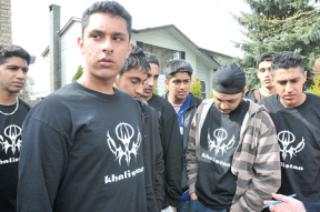
Someone who doesn’t care much about what they do or how they look doing it. Or if you just do something very very stupid.
((Girl walks into classroom for a class one day dressed in XXL sweatpants and a huge baggy sweatshirt, no makeup, hair looks nasty, but shes in perfect good health, just very lazy))
“Wow Anne, you are dressed like a scrub.”
T-shirts are my staple. For every season I have a Sikh camp/organization T-shirt. Need brown, I got it; need blue, I got it; need maroon, I got it. Did I mention I like T-shirts?
Apparently, so do a group of Sikh high school students in Surrey. Recently, the Canadian press reported here and here that:
Thirty students at Princess Margaret Secondary School say they’ve been put on suspension notice after wearing contentious T-shirts to class.
